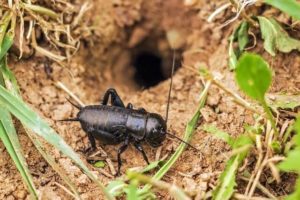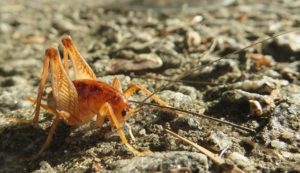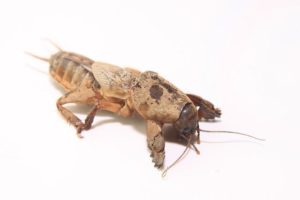Crickets, while harmless for the most part, can be very annoying over time. Imagine trying to sleep in your bedroom downstairs and the chirp chirp chirp chirp chirping keeps you awake. Or maybe imagine relaxing on the couch, just starting a new book and the chirp chirp chirping makes you reread the same sentence 5 times.
We get it. Crickets are annoying. And some varieties of crickets eat fabrics, damaging stored clothes and products in basements and storage rooms. For all of your cricket control needs, look no further than Done Right Pest Solutions, and in the meantime, learn 8 things to do to keep crickets out.
Call Done Right Pest Solutions for a free quote on cricket control: 651-342-9489.
Table of Contents:
Crickets
Crickets are commonly found outside, being related to the grasshopper and katydid, but often enter homes and businesses in the late summer to early fall months.
They enter through small foundational cracks and crevices, like other insect and rodent pests.
The most commonly found crickets indoors are the field cricket, house cricket, and camel cricket.
While crickets do not cause any damage to your home or business, they can be a nuisance with their frequent chirps. Some crickets can cause damage to your stored items and others can damage some grass and plants in the yard. Other than that, crickets do not bite humans or harm them in any way.
Crickets only breed once per year so they aren’t a huge nuisance pest, only very bothersome in the hot and humid months.
Field Crickets – Cricket Control
 Field crickets are the most common cricket in Minnesota. They are the small, ranging between ½ and ¾ of an inch, black crickets. They sometimes can appear to have curved bodies, and they are known for their singing, by which they rub their rounded wings together.
Field crickets are the most common cricket in Minnesota. They are the small, ranging between ½ and ¾ of an inch, black crickets. They sometimes can appear to have curved bodies, and they are known for their singing, by which they rub their rounded wings together.
Of all of the crickets, field crickets fly the best.
If you have field crickets you know you have field crickets. They feed on a variety of plants so if you have a lot of vegetation around your home, you may be in need of cricket control at some point.
Field crickets are also known to eat dying or dead insects, including other crickets. But inside homes, they can eat fabrics and any damp material or garbage.
Because field crickets can make holes in sheets and other linens, clothes, and other items in basement and storage areas, cricket control is very important to keep your things nice. If you only have a few field crickets, rest assured that they don’t often live very long indoors.
Because field crickets can make holes in sheets and other linens, clothes, and other items in basement and storage areas, cricket control is very important to keep your things nice.
Camel Crickets / Cave Crickets – Cricket Control
 Camel crickets look how you may think camel crickets should look: they have a little hump in their back. They are tan or light brown with darker stripes running along their bodies.
Camel crickets look how you may think camel crickets should look: they have a little hump in their back. They are tan or light brown with darker stripes running along their bodies.
Camel crickets do not have wings, and as a result they do not chirp or sing. Camel crickets are also known as cave crickets and often give people the heebie jeebies, like house centipedes. It might be because their non-jumping legs still have an arch and their antennae are long and curved so at a first glance they could be mistaken as a stubby centipede.
These crickets love damp and moist areas inside or outside. Inside they are always found in basements or bathrooms, anywhere there is water and humidity. Outside they are found under logs and feed on decaying organisms and insects.
Unlike field crickets, camel crickets are not attracted to light. They also do not feed on fabrics, but will often feed on paper and paper products. This serves as another reason why cricket control is still important to keep your stored items safe.
Even pest professionals hate camel crickets, because, “They jump on you in the dark. They jump on you. They jump on you. They jump on you. They jump on y …” My sentiments exactly.
House Crickets – Cricket Control
House crickets are yellow to brown in color, but have 3 dark bands behind their heads. For this reason many misinterpret these crickets as a brown-banded cockroach at first glance.
House crickets are similar in size to the field cricket, with their bodies at about ¾ inch long. They have long pointed wings, compared to the field cricket’s rounded wings.
House crickets are more commonly found outside, but they have been known to enter buildings with light. House crickets are very attracted to light.
Once house crickets come inside, they can be extremely destructive consuming fabrics like silk or wool, especially in large numbers. If you have a large amount of house crickets in your home, call a pest control company to eliminate these pests. Cricket control is handy to keep your stored clothes and items intact.
Once house crickets come inside, they can be extremely destructive consuming fabrics like silk or wool, especially in large numbers.
Clothing moths are also a very destructive pest. Give Done Right Pest Solutions a call if you have either house crickets or clothing moths destroying your items.
Mole Crickets – Cricket Control
 Mole crickets appear similar to house crickets, with their lighter tan or brown appearance. They also have short antenna and aren’t known to be very good jumpers or fliers at all.
Mole crickets appear similar to house crickets, with their lighter tan or brown appearance. They also have short antenna and aren’t known to be very good jumpers or fliers at all.
Mole crickets, however, have sharp, shovel-like front claws and are excellent diggers. Because they like to dig, they are found in sandy soil feeding on grass and grass roots. Mole crickets most likely got their names from the yard pest called moles as they dig tunnels below the ground’s surface.
Though mole crickets aren’t attracted to the indoors as much, they are attracted to light, and as a result can find themselves inside homes and businesses.
8 Things to do to Keep Crickets Out
If you have crickets in your basement or home in the hot, humid, and damp times of the year, here is a list of 8 things to do to keep crickets out.
- Close any foundational deficiencies (entry points), like cracks and crevices.
- Make sure all weeds and tall grasses are cut near your home. Homes with more weeds growing up through flower beds or around the foundation attract crickets and they may enter your home.
- Field crickets and house crickets are also attracted to light, so keep your porch lights or outside lights off as much as possible.
- Keep a dehumidifier in the basement. Crickets like damp atmospheres, so if you can dry it out a bit, they will enjoy the conditions less and be more likely to leave.
- Keep your home tidy. By eliminating excess boxes or other clutter from along the floor space, there will be less areas for crickets to hide.
- Crickets like to hide and chirp. If you can eliminate the places they hide, they will try to find other areas they can hide (like under bushes or logs outside).
- You can use sticky traps. Crickets, especially camel crickets, are attracted to sticky traps. Once they jump onto the sticky surface, they cannot get away. These sticky traps serve as a good monitoring tool, as well, to monitor how many of pests you have and what types of pests you have.
- If you’ve got crickets of any kind, be sure to check every dark place they could be hiding. Think of the following areas:
- window wells, around basement windows or in egress windows
- in crawl spaces, vents
- underneath porches, decks, in or under garbage cans
- mulch, stacks of wood, flower beds
- foundation cracks and crevices, around garages, sheds
If you’re looking for more tips and tricks related to jumping insects, check out this category within our blog.
How We Perform Cricket Control
Done Right Pest Solutions employs a variety of techniques to prevent and eliminate crickets in your home or business.
We offer a one-time service using an effective EPA and FDA approved product. It is important to ensure your pest control technicians are using certified safe products. Our product dries within one hour.
The product label targets more than just crickets: typically a plethora of crawling and jumping insects with similar systems and habits. So, when you call Done Right Pest Solutions for cricket control, you’re getting crawling insect control and jumping insect control, too! (and if flying insects land on the product: flying insect control, too!)
Our one-time service comes with a 2 month warranty and includes interior spot treatment and a foundational treatment to cover any areas mentioned that crickets like: weeded areas, cracks and crevices, around basement windows, etc.
Done Right Pest Solutions staff knows that most pests are seasonal, so we created our Peak Seasons Plan which includes cricket control regularly in the spring, summer, and fall.
This plan is crucial if you live in a wooded area or near water. Pests love these areas and often invade homes nearby, just because larger pest populations exist in those areas.
If you’d like to learn more, check out our article, “How to Know if the Peak Seasons Plan is for You” which gives extensive information on each treatment and includes a detailed Q & A portion.
If your business has crickets, please review our Commercial Pest Control page.
Conclusion & Next Steps
You learned a lot about the different types of crickets in Minnesota. Whether you hear the high-pitched chirps of field crickets coming from your basement, or you have camel crickets wander your bathroom on occasion, you are not alone.
Done Right Pest Solutions performs the highest quality cricket control, and you learned how our expert technicians treat. You also learned that year-round cricket control is included in our Peak Seasons Plan.
For all of your cricket control needs, contact Done Right Pest Solutions at 651-342-9489 or donerightpestsolutions@gmail.com.
We can’t wait to help.
Done Right Team
Do you get annoyed of crickets in your house? How did you get rid of them? We’d love to hear from you below!
Want to learn more about different pests? Or maybe about services and promotions we offer? Sign up for our newsletter!

